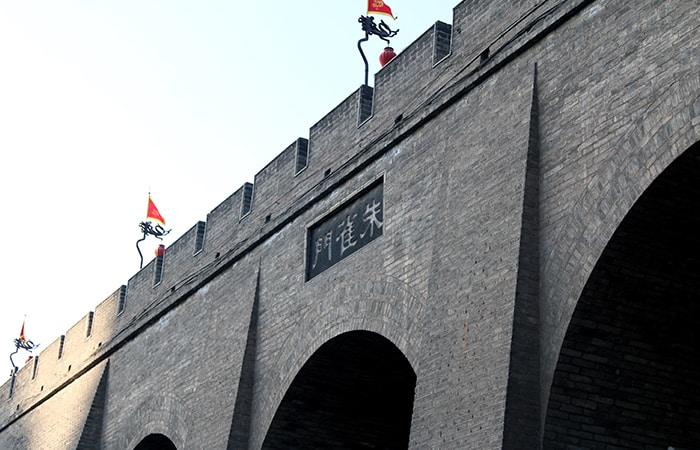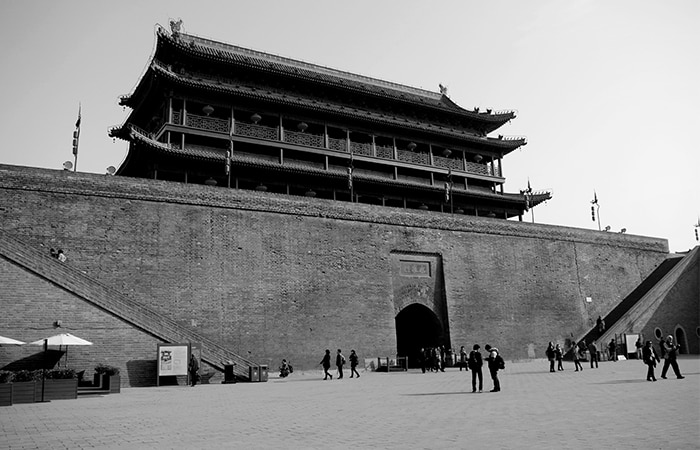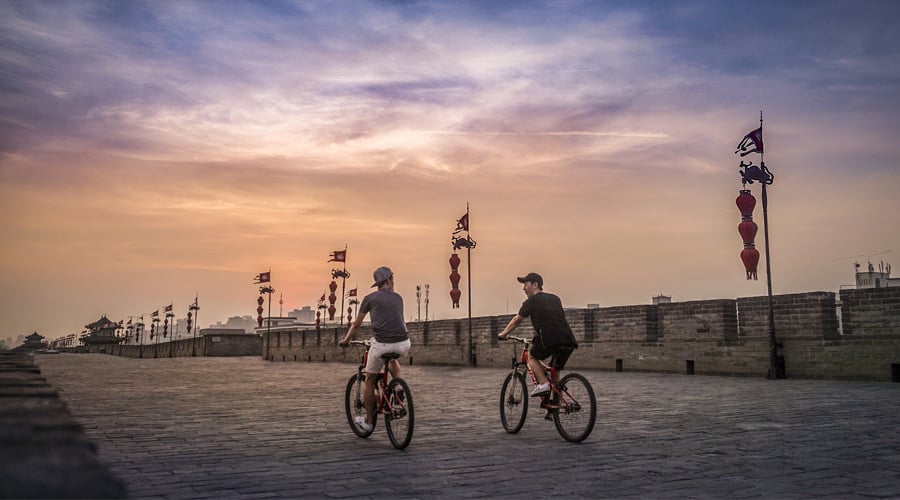When you enter Xi’an, the first landmark you encounter is the ancient Xi’an City Wall. Built around the old town during times when Xi’an served as the imperial capital of China and the starting point of the famed Silk Road, the wall not only defines the city’s historical character but also guides modern urban development. The northern side even parallels the city railway, blending ancient heritage with modern infrastructure.
Historical Significance and City Wall Structure
Xi’an City Wall is a colossal structure that dwarfs its visitors regardless of their height. Originally designed with two main entrance gates—the south and north gates—the wall delineates the old city from the new, with urban development evolving smoothly alongside its timeless ramparts.
Walking, Cycling, or Riding Electric Cars
Visitors who venture on top of the wall have several options to admire the panoramic vistas. You can rent a bike, opt for an electric car tour, or take a leisurely walk. Cycling is popular for the invigorating ride along the historic ramparts, while the electric cars provide a comfortable guided tour. Walking, especially during the cooler afternoons, offers a deeply immersive way to connect with the history. However, during the hot summer months, it’s best to walk early in the morning or after sunset to avoid the heat.

The Story Behind Xi’an City Wall
This enormous wall dates back to the 14th century, during the reign of Emperor Zhu Yuanzhang of the Ming Dynasty. After capturing Huizhou, a hermit named Zhu Sheng advised him to build tall walls and stock provisions, eventually setting the stage for the founding of the Ming Dynasty. Although Zhu Yuanzhang initiated a large-scale campaign to fortify cities with robust defensive walls, the Xi’an City Wall itself was partially constructed on the foundation of an older Tang Dynasty structure which the Ming later enhanced.
Architecture and Defensive Design
The original version of the wall was built using layers of soil mixed with quicklime and glutinous rice extract—an ingenious formula that crafted an exceptionally strong foundation. Over time, bricks replaced the earthen materials, and a wide, deep moat accompanied the construction. A massive drawbridge once spanned the moat to control access to the city.
During the Ming Dynasty, the wall was enlarged into the colossal structure seen today: approximately 39 feet (12 meters) high, 39-46 feet (12-14 meters) wide at the top, 49-59 feet (15-18 meters) thick at the base, and stretching 8.5 miles (13.7 kilometers) in total length. Every 393 feet (120 meters) along the wall, a rampart tower was positioned to provide soldiers with a vantage point for defense and surveillance. In total, 98 ramparts were built, each crowned with a sentry’s building.

The Gates and Towers
Access to Xi’an was highly regulated through its fortified gates. The wall forms a nearly perfect rectangle with a designated gate on each side: north, south, east, and west. These gateways, crucial for the city’s security, each comprise three towers:
Gate Towers Explained
The Gate Tower (Zhalou)
This tower was where the drawbridge was raised or lowered, controlling the city’s access.
The Narrow Tower (Jianlou)
Located in the middle, this tower has thinner walls with rectangular windows strategically placed for archery defense.
The Main Tower (Zhenglou)
This innermost tower provides direct access to the city and served as the primary gate during historical times.
Gate Names and Decorations
The gateways themselves were designed to thwart enemy advances, as attacking a gate was the only way intruders could breach the otherwise impenetrable walls. Each of the four gates has a distinct name:
- Changle (Eternal Joy) – East Gate
- Anding (Harmony Peace) – West Gate
- Yongning (Eternal Peace) – South Gate
- Anyuan (Forever Harmony) – North Gate
Highlight: Yongning Gate
The southern Yongning Gate is the most beautifully decorated entrance, located near the renowned Bell Tower in the city center. Historically, the South Gate Square was the venue for major governmental greeting ceremonies. Fully restored and officially reopened to the public on September 6, 2014, the square spans approximately 7.9 acres (32,000 square meters) and is divided into three sections: the main royal road, the secondary road, and a celebration square. Beneath the square, visitors will find a large underground parking area, two museums, and an archery tower.
Military Stations and Watch Towers
The area between the Gate Tower and the Main Tower, known as Wong Cheng, once served as the quarters for soldiers. This zone also included specially designed sloped passages for horses, enabling swift movement along the wall. In total, the city featured 11 horse passages to support military logistics.
Watchtowers at every corner of the wall—three of which are square and one round (located at the southwestern corner based on Tang architectural influence)—further underscore the strategic military importance of the wall. Each watchtower boasts an extended corner rampart, providing an elevated position for surveillance and defense during battles.
Along the outer crest, you will notice the crenellations or battlements. Originally there were 5,984 battlements, each with a small observation slit below for archers. The lower inner walls are protected by parapets, ensuring the safety of soldiers as they patrolled the wall.

Wall Bike Ride
Riding along Xi’an City Wall on two wheels is a unique way to experience both history and panoramic city views. Whether you’re a cyclist seeking adventure or simply looking for an enjoyable activity, the wall bike ride offers a memorable experience.
| Wall Bike Ride Conditions (Updated 2023) | |
|---|---|
| Time | Approximately 1.5 to 2 hours at a moderate pace |
| Deposit | 100 Yuan |
| Price for a Single Bicycle | 50 Yuan for 3 hours |
| Price for a Tandem Bicycle | 100 Yuan for 3 hours |
| Extended Ride (More than 3 Hours) | 10 Yuan for a single and 15 Yuan for a tandem bicycle |
| Returning Time | Bicycles should be returned by 20:30 at the South Gate and by 18:30 at the other gates |
Sightseeing Electric Car
For a more relaxed tour along the ancient wall, hop into one of the sightseeing electric cars. Enjoy narrated commentary and comfortable seating as you traverse the historic ramparts.
| Prices for a Circle Ride (Updated 2023) | |
|---|---|
| Ordinary Car | 90 Yuan |
| Luxurious Car | 140 Yuan |
| Prices for Visiting Wall-by-Sections | |
| Ordinary Car | 25 Yuan |
| Luxurious Car | 35 Yuan |
| Business Hours | |
| South Gate | 8:00 – 20:30 |
| West, North, and East Gates | 8:15 – 18:30 |
Tourist Guide
The updated tourist guide below provides all you need to know about entering and exploring the Xi’an City Wall. Whether you choose to approach from the south, east, north, or west, convenient metro and bus links make your journey seamless.
| How to Get to Xi’an City Wall (Updated 2023) | |
|---|---|
| The South Gate | Metro Line 2 (Yongningmen Station) or Bus routes 215, 11, 239, 600, 12, and more at South Gate Station |
| The East Gate | Bus routes 45, 102, 203, 218, 235, 252, 300, etc., at the East Gate Station |
| The North Gate | Metro Line 2 (Anyuanmen Station) or Bus routes 6, 26, 28, 33, 37, 39, 117, 205, and others at North Gate Station |
| The West Gate | Bus routes 4, 10, 15, 23, 31, 201, 205, 206, 215, etc., at West Gate Station |
| Ticket Prices (Updated 2023) | |
| Adults | 60 Yuan |
| Children (Between 1.2m – 1.4m) | 30 Yuan |
| Children Under 1.2m | Free |
| Combo Ticket (City Wall and Stele Forest) | 110 Yuan |
| Opening Hours | |
| South Gate | 8:00 – 24:00 |
| Other Gates | May – October: 8:00 – 19:00 / November – April: 8:00 – 18:00 |
Note: The weather in Xi’an tends to be dry with strong UV exposure during the summer, so always carry water, apply sunscreen, and wear sunglasses. If you plan on walking along the wall, dress in comfortable attire to enjoy this historic trek.
For more information about exploring other historical sites in Xi’an, visit our dedicated page on Xi’an travel guides. Feel free to leave your comments or questions—we’d love to hear your feedback!






